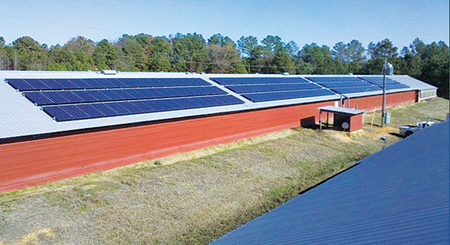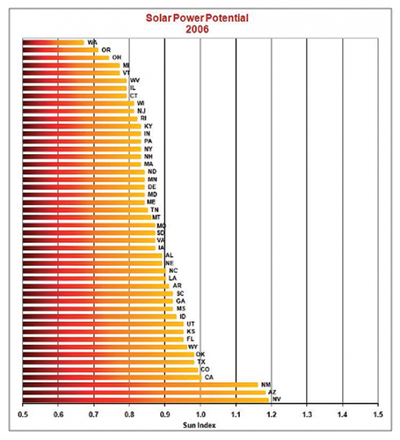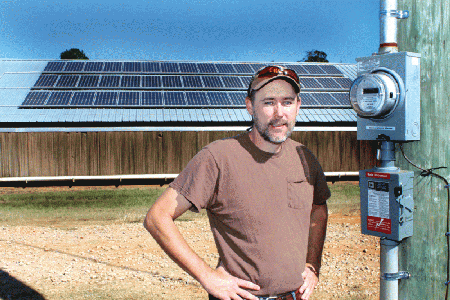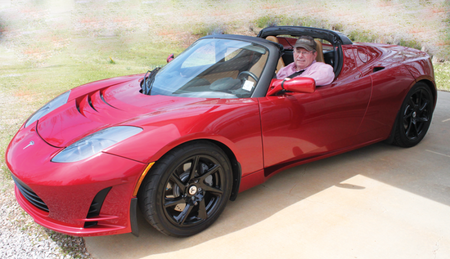
Even with the economic and environmental advantages of solar technology, there is a lot of misinformation about it, and Mississippians have been slow to embrace it, says Will Hegman. “People say Mississippi isn’t geographically suited to solar power, that there isn’t enough solar radiation here, that solar systems are unreliable, that solar is just a fad, and on and on.” But, says Hegman, the facts are that solar systems are extremely reliable and can be economically feasible for many Mississippi farmers, homeowners, businesses, schools, churches, and almost any structure that needs electricity.

When he’s driving his eye-popping Tesla sports car or his Nissan Leaf mini-wagon, Will Hegman just smiles as he passes gas stations. Pump prices don’t concern him. Both vehicles run on electricity alone.
A solar carport charges the car batteries. Another solar array provides power for his shop.

POULTRY HOUSES, with their large roof area and usual east-west siting are ideal for solar arrays. This installation is on the farm of Lena, Miss., poultry producer Andy Stone, who expects the 280-panel system to pay for itself in five years.
And when the year's charges for electricity are totaled, he often smiles again as he sees an amount owed him. Electricity produced by his solar array is uploaded to the electric grid and he is paid for that power under a contract with the Tennessee Valley Authority. The amount he receives for his solar-generated electricity often more than offsets what he is charged for electricity from his local power association.
Hegman’s wife, Carolyn, who commutes to Jackson, Miss., and then Dallas for her work as a flight attendant on American Airlines international routes, drives an energy-efficient Toyota Prius hybrid.
“Our personal use of energy from fossil fuels is negligible,” says Will, a native Mississippian and retired commercial pilot who became interested in the possibilities of solar while working in the Caribbean. “Unfortunately, I spend a chunk of money each month on diesel for the company trucks.”
Their company, MS Solar, at Philadelphia, Miss., in operation for seven years, has marketed, designed, and installed solar systems in poultry operations, farm shops, businesses, schools, homes, and other facilities, helping owners to utilize the sun’s free and abundant energy to reduce costs and environmental footprint.
MS Solar installed a 50 kW system at the new $2 billion Toyota facility at Blue Springs, Miss. — the only tracking solar array in Mississippi.
AG NEWS delivered daily to your inbox: Subscribe to Delta Farm Press Daily
Despite the advantages of the technology, economically and environmentally, there is a lot of misinformation about it, he says. “It’s like the wild, wild west, in terms of the availability of solid facts about solar, and in terms of standards, regulations, etc.
“People say Mississippi isn’t geographically suited to solar power, that there isn’t enough solar radiation here, that solar systems are unreliable, that solar is just a fad, and on and on.”
But, says Hegman, the facts are that solar systems are extremely reliable and can be economically feasible for many Mississippi farmers, homeowners, businesses, schools, churches, and almost any structure that needs electricity.
Solar index favors Mid-South

SOLAR INDEX shows solar radiation rankings for each state.
Government data show a year-round average of 5 peak solar hours daily, and the National Renewable Energy Laboratory’s ranking of states lists Mississippi as having 10th highest solar power potential in the U.S. (Arkansas is 11th, Louisiana 12th, Missouri 14th, and Tennessee 16th). The rankings are based on the sun index, which calculates the amount of direct sunlight received in each state and accounts for latitude and cloud cover. California is indexed at 1.0. The sun index is calculated as the average number of hours of peak direct sunlight hours per year from 1960 to 1990.
“It’s commonplace to gripe about the cost of gasoline,” Hegman says, “yet a lot of those same people won’t even consider this new technology that could save them money while silently, reliably producing electricity and offering them a hedge against rising energy costs.
“I don’t know what oil prices are going to be in the years ahead — almost everyone expects they will go up. But scientists tell us the sun will be radiating energy for at least another 5 billion years. Why not capitalize on this abundant source of energy? Long after oil is gone, solar panels will be using the sun’s rays to generate clean electricity. Compared to the cost of a nuclear plant, and all the construction costs and environmental concerns they entail, solar power is a bargain.
“If you discount the billions of subsidies we’re still giving to the oil companies, the cost of solar is already almost on a parity with oil. And it’s going to continue to be cheaper as the cost of panels and related equipment go down.”
Poultry production is big business in Leake County and several surrounding counties; a Tyson poultry plant at nearby Carthage processes millions of birds weekly and has some 2,000 employees.
It’s an energy-intensive business, Hegman notes, with huge tunnel fans used to ventilate the houses during hot summers, and propane for heating during the winter, plus lighting requirements.
“Solar can really change the life of a poultry farmer,” he says. “We did a study showing that if all the poultry houses in Mississippi installed solar arrays, that industry alone could offset 10 percent of the state’s electrical use from conventional generating plants.”
With their large roof surfaces and, in most cases, east-west siting, poultry houses are ideal for installation of enough solar panels to generate the electricity needed for cooling and lighting, and enough excess to offset the cost of propane for heating through rebates from the power company.
Many applications in agriculture
Solar systems can cut costs for other agricultural operations — boat houses, horse barns, and a wide variety of applications, Hegman says. In addition to potential savings on energy costs, the systems help reduce environmentally harmful carbon emissions.
While the cost of solar panels has dropped sharply — from about $9 per watt in 2008 to around $3.28 today — he says in Mississippi it’s a technology that’s still little understood, which has been a roadblock to wider adoption.

SUN POWER: These solar arrays provide electricity for Will Hegman’s shop and to offset the electricity purchased from his electric power association for his home.
Several years ago, the Tennessee Valley Authority — the dominant electricity provider over much of the Appalachian region, which includes much of east Mississippi — initiated a solar incentives program, Generation Partners, to encourage installation of systems throughout its territory. That was followed by its Green Power Switch program, in which participants could sell power from their solar installations to TVA at a favorable rate that would not only offset their normal power usage, but would result in a payment for any excess electricity generated.
A federal tax credit of 30 percent of the cost of the installed system was an additional incentive (the credit will continue through 2016).
In 2012, an estimated 12,000 homes, farms, and businesses in the TVA area were participating in the Green Power Switch program.
It was unfortunately, Hegman says, a case of a program being too successful, and TVA imposed a cap on participation, as well as reducing the rate it would pay for purchasing solar-generated electricity.
In 2013, according to news reports, TVA’s yearly capacity for the capped program was subscribed within one minute of its opening on Aug. 1.
Citing continued “strong interest,” TVA announced that for 2014 it would continue to cap the program, and would only take enrollment requests during a one-month period, Jan. 15-Feb. 17. If requests exceeded the cap, a “random selection process” (lottery) would be used to select those allowed to complete the full application process.
TVA was not the only utility to drastically cut back on solar incentives; nationally, power companies were complaining about losing revenue, and green power programs were slashed or eliminated, casting a pall on an industry that was beginning to grow during a period of rising energy prices.
The cutbacks were a blow to the industry, which had an estimated 100,000 employees nationwide.
Further exacerbating the situation were highly publicized bankruptcies of the California-based solar company Solyndra, which had received $535 million in federal loans, and Colorado-based Abound Solar, with $400 million in federal loans.
Lack of standards, regulations
Aside from the reluctance to embrace new technology, Hegman says, standards and regulations for the solar industry run the gamut from inconsistent to non-existent. Even among power companies, interconnection, installation, metering, and operating requirements for solar systems are widely varied and interpreted. “They all seem to have their own particular spin on things, and trying to cope with them can be awfully frustrating.”

SPENCER POPE installed a solar system on his poultry farm and electricity generated and uploaded to the grid offsets power used to cool his poultry houses, as well as much of the costs of propane for heating in the winter.
Additional frustration is often encountered at the state level, where agencies may have differing regulations, permits, licensing, and fee structures. While states have training and qualification standards established for professions ranging from cosmetology to truck driving, that may not be the case for solar installers — often, it’s just a matter of paying a fee for a license.
Because solar is still new in comparison to other energy forms, Hegman says, applications for agriculture have not been as much in the forefront as for homes and businesses. “There just hasn’t been a lot of research done on other agricultural applications.
“But I would think the potential is there. Solar arrays could be sited on any non-productive land to generate power for farm use. Most producers, for example, would prefer to use electricity for pumping irrigation water, because it’s so much cheaper than running a big diesel engine. But often there are no nearby power lines, and running lines to pumps is prohibitively expensive. It would be interesting to research how solar might be used to power remote pumping systems.
“Even if there wasn’t room for a solar array, an alternative might be a battery array that could be charged by the diesel generator. The batteries could power the pump for a portion of its run time, thus reducing the amount of expensive diesel fuel required.
“I know from my own experience that solar is completely workable for powering a farm shop,” Hegman says. “But what about as a supplemental power source for grain drying? Or providing power for hog confinement facilities? And a lot of farmers have remote hunting cabins, where solar could be utilized.”
Hegman is an advocate of taking easy steps to make all new homes solar ready, generator ready, and electric vehicle ready.
“This would include roof access for wiring to a solar array, a connection for an external generator in case of complete power failure, and provision for solar charging of electric vehicles. The cost is relatively little at the time of construction, and even if the homeowner doesn’t want any of these technologies now, the infrastructure will be there in the future. To go in and add these after the fact would cost a lot more.” But, he says, builders continue to be reluctant to do this.
Never a gas pump stop
And about those electric cars: The Tesla, with its carbon composite body and a direct drive electric motor that will take it from zero to 60 mph in under 4 seconds, is one of a 2,500 limited edition production from the startup California car company founded by Internet billionaire Elon Musk.

"AN AMAZING piece of technology," says Will Hegman of the all-electric limited edition Tesla roadster, which will go 0-60 mph in less than 4 seconds.
While Hegman acknowledges that the Tesla’s north-of-$100,000 price tag makes the idea of fuel savings moot, “It is an amazing piece of technology, and it’s a great promotional tool for American ingenuity and alternative energy.
“In addition to never buying gasoline, there are no oil/filter changes, no transmission or fuel pump, no exhaust/muffler system, none of the many parts and systems associated with gasoline engines. And the power of the electric motor is phenomenal; acceleration from a standing start is right there with a Corvette or Ferrari — and it’s instantaneous, no lag whatever.”
All the car’s systems can be monitored remotely via a smart phone app, and operational data are transmitted to Tesla for analysis.
Tesla is now building an all-electric sedan, cranking out about 600 per week at its California assembly plant, and the company is in the process of building a nationwide network of solar charging stations where owners can “fill up” for free.
Hegman’s Tesla roadster has a range of 200-plus miles, depending on speed and other factors. But for his everyday commute from home to office, he uses the Nissan Leaf, which is only about one-fourth the price of the Tesla.
Though not nearly so powerful, “It’s a great vehicle,” he says. “And it’s so satisfying to never have to stop at a gas pump.”
About the Author(s)
You May Also Like



